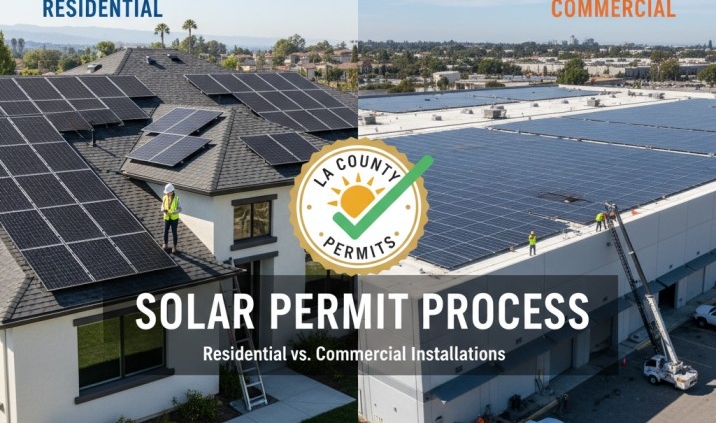Solar Permit Process in LA County: Residential vs. Commercial Installations
Thinking about installing solar panels in Los Angeles County? Before the first panel goes on your roof, there’s one important step you cannot skip – getting a solar permit in LA County. Whether you’re a homeowner looking to lower your electricity bill or a business planning to cut energy costs, the permit process is what ensures your solar project is safe, legal, and built to code.
In this guide, we’ll break down the solar permit application process for both residential solar permits and commercial solar permits, highlight key differences, and explain the solar panels permit requirements you need to know.
Why a Solar Permit Matters in LA County
A solar permit is more than just paperwork – it’s your official approval from the county that your solar installation meets safety standards and building codes. It protects you as a homeowner or business owner and ensures your system qualifies for incentives, rebates, and net metering programs offered by California utilities.
Without a permit, you could face penalties, delays in connecting to the grid, or even problems if you decide to sell your property.
Solar Permit Application: Where It Begins
The solar permit application in LA County is filed through the Department of Public Works (for unincorporated areas) or the local city building department (if you live within city limits). The application usually requires:
- Completed permit forms
- Solar panel layout and design plans
- Electrical drawings and load calculations
- Structural calculations for roof-mounted systems
- Contractor license information
Many jurisdictions in LA County now accept online applications, which speeds up the review process.
Residential Solar Permits: What Homeowners Need to Know
For homeowners, the process is fairly straightforward. Residential solar permits in LA County cover single-family homes and small multi-family buildings. The county uses a “streamlined” permitting process for solar systems under a certain size (typically less than 10 kW).
Typical requirements for residential permits include:
- Proof of property ownership
- Roof structural analysis to confirm it can handle solar panels
- Compliance with California Electrical Code
- Fire safety access pathways on the roof
In many cases, permits are issued within a few days if the documents are correct. After installation, an inspector will visit to make sure everything matches the approved plans.
Pro Tip: Hiring an experienced solar contractor can simplify the application, since most companies handle the paperwork for you.
Commercial Solar Permits: What Businesses Should Expect
If you own a business or commercial property, the process is more detailed. Commercial solar permits apply to larger systems, often installed on rooftops, carports, or open land. Because commercial projects involve higher voltages, heavier structures, and more complex designs, the review process takes longer.
Typical requirements for commercial permits include:
- Detailed engineering and structural reports
- Fire department review for safety and access
- Environmental impact checks (for ground-mounted projects)
- Electrical interconnection approvals with the utility
The review process can take several weeks, depending on the project size and location. Businesses should plan ahead to avoid delays.
Key Differences: Residential vs. Commercial Permitting
| Factor | Residential Solar Permits | Commercial Solar Permits |
| System Size | Usually under 10 kW | Can range from 20 kW to several MW |
| Review Time | 1–5 business days (if plans are complete) | 2–6 weeks (depending on complexity) |
| Documents Needed | Basic structural and electrical drawings | Detailed engineering, fire safety, utility interconnection |
| Inspection | Single inspection after installation | Multiple inspections during and after installation |
Solar Panels Permit Requirements in LA County
No matter if it’s residential or commercial, the solar panels permit requirements usually include:
- Engineering Plans – showing how panels will be mounted and wired.
- Electrical Diagrams – detailing circuits, inverters, and safety shutoffs.
- Roof or Ground Calculations – to ensure structural safety.
- Fire Safety Compliance – meeting California Fire Code spacing rules.
- Contractor Licensing – proof that your installer is licensed in California.
These requirements exist to guarantee that your solar system is both safe and efficient.
How Long Does It Take to Get a Solar Permit in LA County?
- Residential projects: 1–5 days if paperwork is complete.
- Commercial projects: 2–6 weeks due to engineering reviews and utility checks.
If you’re on a timeline, make sure your application is 100% accurate before submission. Missing documents are the #1 reason for delays.
Frequently Asked Questions
Q1. Do I really need a solar permit in LA County?
Yes. Permits are required for both residential and commercial solar projects to ensure compliance with building and electrical codes.
Q2. Who files the solar permit application – me or the contractor?
Most solar installers handle the application on your behalf, but ultimately, the property owner is responsible.
Q3. How much does a solar permit cost in LA County?
Fees vary by jurisdiction but typically range between $150–$500 for residential projects and higher for commercial systems.
Q4. Can I install solar panels without a permit?
No. Installing without a permit could result in fines, removal orders, or issues with utility approval.
Q5. What happens after I get the permit?
Once the permit is approved, your installer can begin work. After installation, an inspection is required before the system connects to the grid.
Final Thoughts
The process of getting a solar permit in LA County may feel like red tape, but it’s a crucial step that protects your investment and ensures your solar system meets all safety standards. For homeowners, the residential solar permits process is faster and simpler, while commercial solar permits require more time and documentation.
By understanding the solar permit application requirements and preparing in advance, you can avoid delays and get your system connected to the grid smoothly. With California’s push toward clean energy, now is the perfect time to start your solar journey.



Leave a Reply
Want to join the discussion?Feel free to contribute!